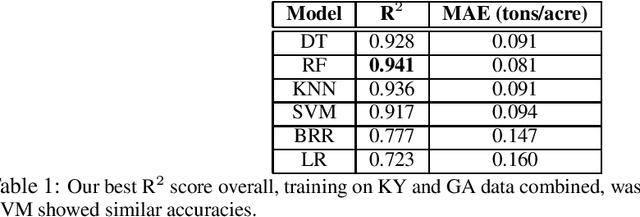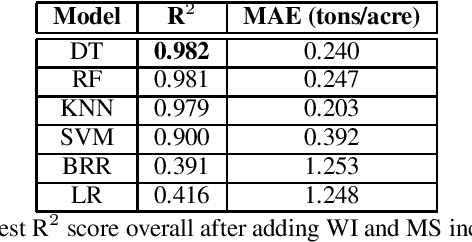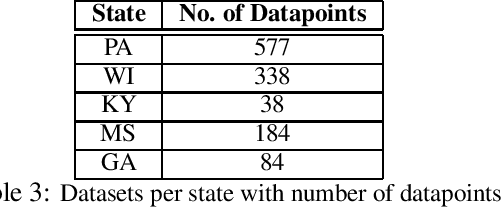Chris Whitmire
Comparing Machine Learning Techniques for Alfalfa Biomass Yield Prediction
Oct 20, 2022


Abstract:The alfalfa crop is globally important as livestock feed, so highly efficient planting and harvesting could benefit many industries, especially as the global climate changes and traditional methods become less accurate. Recent work using machine learning (ML) to predict yields for alfalfa and other crops has shown promise. Previous efforts used remote sensing, weather, planting, and soil data to train machine learning models for yield prediction. However, while remote sensing works well, the models require large amounts of data and cannot make predictions until the harvesting season begins. Using weather and planting data from alfalfa variety trials in Kentucky and Georgia, our previous work compared feature selection techniques to find the best technique and best feature set. In this work, we trained a variety of machine learning models, using cross validation for hyperparameter optimization, to predict biomass yields, and we showed better accuracy than similar work that employed more complex techniques. Our best individual model was a random forest with a mean absolute error of 0.081 tons/acre and R{$^2$} of 0.941. Next, we expanded this dataset to include Wisconsin and Mississippi, and we repeated our experiments, obtaining a higher best R{$^2$} of 0.982 with a regression tree. We then isolated our testing datasets by state to explore this problem's eligibility for domain adaptation (DA), as we trained on multiple source states and tested on one target state. This Trivial DA (TDA) approach leaves plenty of room for improvement through exploring more complex DA techniques in forthcoming work.
Origami Inspired Solar Panel Design
May 15, 2019



Abstract:The goal of this paper was to take a flat solar panel and make cuts on the panel to make smaller, but still viable solar panels. These smaller solar panels could then be arranged in a tree-like design. The hope was that by having solar panels faced in different directions in 3-dimensional space, the tree system would be able to pick up more sunlight than a flat solar panel. The results were promising, but this project did not take every factor into account. Specifically, optimum shape, temperature and the resistance of system, reflection of sun-rays were not explored in this project. This paper will take an approach from origami paper folding to create the optimum arrangement that will allow the overall system to absorb the maximum energy. Since the system stays stationary throughout the day, it can reduce the maintenance cost and excess energy use because it does not require solar tracking. In this project we have implemented a variety of Evolutionary Algorithms to find the most efficient way to cut a flat solar panel and arrange the resulting smaller panels. Each solution in the population will be tested by computing the amount of solar energy that is absorbed at particular times of the day. The EA will be exploring different combinations of angles and heights of the smaller panels on the tree such that the system can produce the maximum amount of power throughout the day. The performance of our Evolutionary algorithms are comparable to the performance of flat solar panels. Keywords: - Evolutionary Programming, Evolution Strategy, Genetic Algorithm, Solar Panel Optimization.
 Add to Chrome
Add to Chrome Add to Firefox
Add to Firefox Add to Edge
Add to Edge